|

It is a large whale: an adult usually ranges between 12–16 m (40–50 ft) long and weighs approximately 36,000 kilograms (79,000 pounds), or 36 tonnes (40 tons).

Feeding in the summer, living off fat in winter: The species feeds only in summer and lives off fat reserves during winter. It is an energetic feeder, taking krill and small schooling fish, such as herring, capelin and sand lance. It will hunt fish by direct attack or by stunning them by hitting the water with its flippers or flukes.
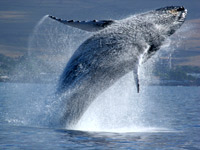 Amazing acrobats:
Humpbacks often 'breach': they leap out of the water with enough upward force that nearly two-thirds of the body comes out of the water, and then comes back to the water again with an enromous splash. Sometimes a twist is involved in the jump, a sideways motion or many other impressive acrobative feats. They have also been seen rolling in the water, slapping the water with their flippers and fluke, butting into other whales and also lifiting themselves straight up out of the water. This often makes whale-watching an extremely exciting event! Amazing acrobats:
Humpbacks often 'breach': they leap out of the water with enough upward force that nearly two-thirds of the body comes out of the water, and then comes back to the water again with an enromous splash. Sometimes a twist is involved in the jump, a sideways motion or many other impressive acrobative feats. They have also been seen rolling in the water, slapping the water with their flippers and fluke, butting into other whales and also lifiting themselves straight up out of the water. This often makes whale-watching an extremely exciting event!
Orca bullies: Humpback whales are preyed upon by Orcas. The result of these attacks is generally nothing more serious than some scarring of the skin. However, it is likely that young calves are sometimes killed.
 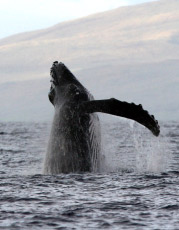 Blowing bubbles for a big gulp: Its most inventive feeding technique is called bubble net fishing. A group of whales swims rapidly in wide circles around and under a school of fish, blowing air through their blowholes. The bubbles form a visual barrier that serves to confine the school within an ever-tighter area. The whales then suddenly swim upwards and through the bubble net, mouths agape, swallowing thousands of fish in one gulp. This technique can involve a ring of bubbles up to 30 m (100 ft) in diameter and the cooperation of a dozen animals at once. It is perhaps the most spectacular act of cooperation among marine mammals. Blowing bubbles for a big gulp: Its most inventive feeding technique is called bubble net fishing. A group of whales swims rapidly in wide circles around and under a school of fish, blowing air through their blowholes. The bubbles form a visual barrier that serves to confine the school within an ever-tighter area. The whales then suddenly swim upwards and through the bubble net, mouths agape, swallowing thousands of fish in one gulp. This technique can involve a ring of bubbles up to 30 m (100 ft) in diameter and the cooperation of a dozen animals at once. It is perhaps the most spectacular act of cooperation among marine mammals.
Complex singers: Alongside its aerial acrobatics, the Humpback whale is well known for its long and complex "song". As cetaceans have no vocal chords, whales generate their songs by forcing air through their massive nasal cavities. Humpbacks repeat patterns of low notes that vary in amplitude and frequency in consistent patterns over a period of hours or even days. Scientists are still unsure what the whalesong is meant to communicate. Only male Humpbacks sing, so it was at first assumed that the songs were solely for courting. While the primary purpose of whalesong may be to attract females, it's almost certain that whalesong serves myriad purposes. Also interesting is the fact that a whale's unique song slowly evolves over a period of years —never returning to the same sequence of notes even after decades.

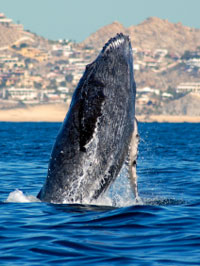 Curiousity used to mean big trouble: Humpback whales are generally curious about objects in their environment. They will often approach and circle boats. Whilst this inquisitiveness was akin to suicide when the vessel was a whaling ship, it has become an attraction of whale watching tourism in many locations around the world since the 1990s. Curiousity used to mean big trouble: Humpback whales are generally curious about objects in their environment. They will often approach and circle boats. Whilst this inquisitiveness was akin to suicide when the vessel was a whaling ship, it has become an attraction of whale watching tourism in many locations around the world since the 1990s.
Curiousity works for whale-watching though: Whale-watching locations include the Pacific coast off Washington, Vancouver, Hawaii and Alaska, the Bay of Biscay to the west of France, Byron Bay north of Sydney, the coasts of New England and Newfoundland, the northern St. Lawrence River and the Snaefellsnes peninsula in the west of Iceland. The species is popular because it breaches regularly and spectacularly, and displays a range of other social behaviors.
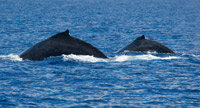 Protective mothers: As with other cetacean species, however, a mother whale will generally be extremely protective of her infant, and will seek to place herself between any boat and the calf before moving quickly away from the vessel. Whale-watching operators are asked to avoid stressing the mother unduly. Protective mothers: As with other cetacean species, however, a mother whale will generally be extremely protective of her infant, and will seek to place herself between any boat and the calf before moving quickly away from the vessel. Whale-watching operators are asked to avoid stressing the mother unduly.

Preying whalers: The first recorded Humpback kill was made in 1608 off Nantucket. Opportunistic killing of the species is likely to have occurred long before then, and certainly continued with increasing pace in the following centuries. By the eighteenth century, the commercial value of Humpback Whales had been realized, and they became a common prey of whalers for many years.
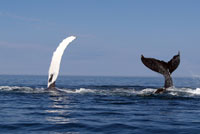 Explosive harpoons were bad news to friendly whales: By the 19th century, many nations (in particular, the United States), were hunting the creature heavily in the Atlantic Ocean — and to a lesser extent in the Indian and Pacific Oceans. However, it was the introduction of the explosive harpoon in the late nineteenth century that allowed whalers to accelerate their take. This, coupled with the opening-up of the Antarctic seas in 1904, led to a sharp decline in whale numbers amongst all populations. Explosive harpoons were bad news to friendly whales: By the 19th century, many nations (in particular, the United States), were hunting the creature heavily in the Atlantic Ocean — and to a lesser extent in the Indian and Pacific Oceans. However, it was the introduction of the explosive harpoon in the late nineteenth century that allowed whalers to accelerate their take. This, coupled with the opening-up of the Antarctic seas in 1904, led to a sharp decline in whale numbers amongst all populations.
90% gone is a terrible crime : It is estimated that during the 20th century at least 200,000 Humpbacks were taken, reducing the global population by over 90%. To prevent species extinction, a general moratorium on the hunting of Humpbacks was introduced in 1966 and is still in force today. In his book Humpback Whales (1996), Phil Clapham, a scientist at the Smithsonian Institute, says "this wanton destruction of some of the earth's most magnificent creatures [is] one of the greatest of our many environmental crimes".
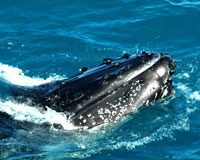 Stopping barely in time: By the time the International Whaling Commission members agreed on a moratorium on Humpback hunting in 1966, the whales had become sufficiently scarce as not to be worthwhile hunting commercially. At this time, 250,000 were recorded killed. However, the true toll is likely to be significantly higher. It is now known that the Soviet Union was deliberately under-recording its kills; the total Soviet Humpback kill was reported at 2,710 whereas the true number is now believed to be 48,000. Stopping barely in time: By the time the International Whaling Commission members agreed on a moratorium on Humpback hunting in 1966, the whales had become sufficiently scarce as not to be worthwhile hunting commercially. At this time, 250,000 were recorded killed. However, the true toll is likely to be significantly higher. It is now known that the Soviet Union was deliberately under-recording its kills; the total Soviet Humpback kill was reported at 2,710 whereas the true number is now believed to be 48,000.
Starting in 2007 Japan is planning to kill 50 Humpback Whales per year under its JARPA-II research program.
Some text is available under the terms
of the GNU Free Documentation License
|